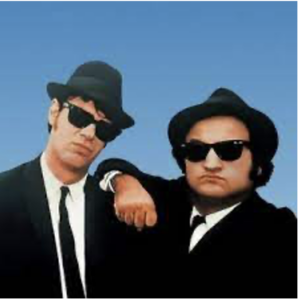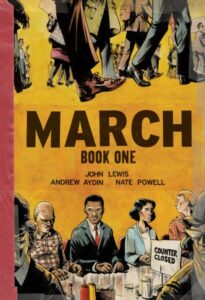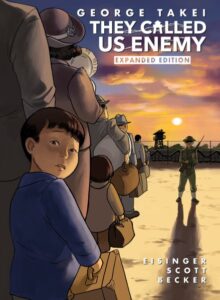This past Sunday I missed a program at the Illinois Holocaust Museum and Education Center that I would have enjoyed greatly. You see, recently a graphic novel was developed in partnership with the museum called Hour of Need. The story shares the true story of how the people of an occupied nation risked their lives to evacuate their Jewish countrymen. Here’s the description:
“When Nazis moved to round up Danish Jews in a surprise raid in 1943, families were forced to make life-and-death decisions to save their lives. Overnight, they became refugees at the mercy of strangers organizing their escape. Hour of Need is a tribute to these strangers – ordinary citizens who defied the Nazi regime – and how their heroic actions saved Danish Jews.
I wasn’t able to see author Ralph Shayne in conversation with illustrator Tatiana Goldberg, so we figured we’d present you with some info on the book in another way. Today Ralph joins us for a guest post on the creation of his book, told in his very own inimitable style.
SCROLL TO KEEP READING THIS POST
ADVERTISEMENT
ADVERTISEMENT
In 2017, I had my Jake Blues moment at the Triple Rock Baptist Church. Instead of the South Side of Chicago, I was on the north side at my alma mater, the Francis W. Parker School. And instead of being inspired by the sermon of Reverand Cleophus James (as channeled by the legendary James Brown), I was unexpectedly inspired by the legendary late US Congressman John Lewis and his co-author Andrew Aydin. I saw the light! Just as this duo created an amazing autobiographic graphic novel, March, about Lewis’ coming of age as a student leader in the civil rights movement, I could use this same powerful medium to bring my mother’s Holocaust escape story to life. The idea for my graphic novel, Hour of Need, which releases on Sept 13th, was born.
I’ll admit that I have never grown out of being a comic book fan. And when I was a high school collector in the ‘80s, I remember setting my eyes on Frank Miller’s game changing The Dark Knight graphic novel. Too pricey for me at $2.95 when standard comics were going for $.60. But my friend Mike was a high roller and I got to read his edition. Then I became an adult. I still have my 200+ comic collection from the ‘80s, and occasionally break them out to admire the Frank Millers I was able to scrounge up and by back then. (The Frank Miller Daredevil series is my prize!)
And I was able to pony up for the $19.95 that the first volume of the March trilogy (who is the high roller now?). I fell in love with Nate Powell’s art, how it made me feel immersed in the American South of the 1950s and how it filled me with pride of the election of our first black president. And I was impressed to learn how it had become a staple in schools across the country as a way to teach the civil rights movement.
My mother had died the year before after a productive 81 years. I knew growing up that as a child turning nine, she had to flee with her family and got stowed away on a fishing boat that dodged Nazi patrols to take her to Sweden, where she spent the rest of World War II as a refugee. This was one small part of a bigger story, the rescue of the Danish Jews. Over 700 trips on fishing boats rescued most of Denmark’s Jews after word leaked of an impending Nazi round up. Unlike many Holocaust stories, my mother’s story had heroes. Everyday heroes. Real heroes. And the world needs to hear more about the heroes that were there during one of humanity’s darkest hours. I felt she had a story that needed to be told.
A book had been written about my mother’s rescue and had published excerpts from my family’s diaries. A band came together that saved my mother 80 years ago this September and October. Members included everyday Danish people of all sorts – a math teacher, an insurance man, a hotel clerk and more. However, the book about her experience runs over 500 pages of text. You would think your children would eagerly want to read a story that features their beloved grandmother and even has pictures of her as a child. But try pitching a teenager, even ones prideful of their Jewish heritage, on reading a 500 page history book about the Holocaust. Good luck. Not accessible, not interested. To his credit, my son did roll up his sleeves and give it a read but he considered it a painful slog. A textbook just does not convey the emotions and drama the way a graphic novel does.
So how does one create a graphic novel? I did not know this when I saw the light. But I knew that there were people I could ask and who I would need to help. Yes – I had to put another band together to create what would become Hour of Need. Ok – not back together like Jake Blues’ vision. But give me some poetic license, please. I was, after all, on a mission from G-D.
First stop – the pro. That eloquent twenty-something legislative aid and co-author who could share the stage with the mesmerizing John Lewis. Yes, Andrew Aydin. He had the vision to turn John Lewis’ life story into a graphic novel after traveling with this civil rights icon and being amazed at how little people knew about who he was and what he had done for our country. I tracked him down and found him to be uber generous with his advice. He had an impressive story on how he sold the concept of a John Lewis graphic novel to a publisher over the table at a Comic Con with script fragments he had created. He paid it forward and gave me tips that I used to roadmap the rest of my journey.
Next stop – Comic Con to meet artists. Actually, I started with C2E2 when it came to Chicago. I passed on the cosplay. I read up on the artists that would be at artist alley. One popped out – Dan, who also happened to be an instructor at a comic book academy. I went equipped with a plot summary and a business card, and got mostly funny looks. That’s when I got the advice on how to make a small fortune. Start with a large fortune and then make comics. I met lots of nice artists, paid tribute to their works by buying copies of their wares but it was not until I met Dan that I found a soulmate. Or at least someone interested in my project and willing to give me advice on the business of hiring artists.
Then the partner. With a plot summary in mind and now an idea on the creative budget, I decided I would not make the investment in time and money if I did not have the confidence it would reach people. After all, if a graphic novel is published in the forest, will anyone ever read it? My natural instinct? Find a supportive Jewish organization, particularly one that prides itself on innovation. As luck would have it, Chicago’s suburb of Skokie (yes, the same location as the Illinois Nazi march in the Blues Brothers, and not a coincidence) houses the world’s 3rd largest Holocaust museum, the Illinois Holocaust Museum & Education Center. I pitched my project and came equipped with family memorabilia from pre-War and Wartime. A partnership was born. The catch – we would find a credible publisher with distribution and not self-publish.
The mentor. I took a stab at writing a script, and lucked out when I was able to convince a mother at my children’s school to read it for feedback. Not just any mother, but one who had received an Emmy nomination for a movie she wrote. Completely transformative.
The agent. Yes, I love saying I have an agent. Only took two years to find one, even with the Museum’s backing. Complete serendipity. He specializes in business books but found my book “mission-based” (I was, after all, still on a mission from G-d). After toiling away for attention from publishers myself, he went out to market and came back with five offers.
Cannot forget the artist. March beautifully captures the soul of the South in the 1960s. The artwork from George Takei’s They Called Us Enemy is perfectly suited for the experience of Japanese internment during World War II.
SCROLL TO KEEP READING THIS POST
ADVERTISEMENT
ADVERTISEMENT
How do I capture Denmark? Can I really bring an American artist over there for a week and have him or her come back with the appreciation of how to make Hour of Need look Danish? I have to admit that when Mitt Romney said that the trees in Michigan are just the right height, he was on to something. The obvious answer – find a talented Danish artist. And I did. Then he fired me when he was not interested in my input on his drawings, though he did it in a nice way. And that led me to find The One. Tatiana Goldberg, whose grandfather had lived only a few miles from mine outside of Copenhagen.
She had already done her own short novella about her grandfather’s experience with the Nazis. She knew the height of the trees, the look of the curbs circa 1943, and had an eye for detail that surpassed everything I could imagine. And a creative style I fell in love with at first sight.
And now, after a five year journey, my mother’s story and what the Danish people did to save their Jews will come to light this September with the release of Hour of Need. Now I need The Pro’s crib sheet on how to build awareness in schools that the middle grade graphic novel to discuss the Holocaust with inspirational stories of all the real heroes who helped my mother has arrived. I have a full tank of gas, it’s dark outside and I am wearing sunglasses. Hit it.
Many thanks to Ralph Shayne for guesting here today. His new book Hour of Need is in bookstores and libraries everywhere today. Thanks too to Paul Crichton and the folks at Little Bee for helping to set this up.
Filed under: Guest Posts









